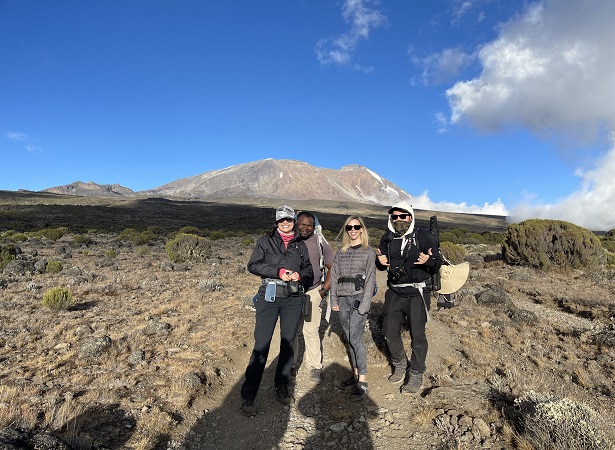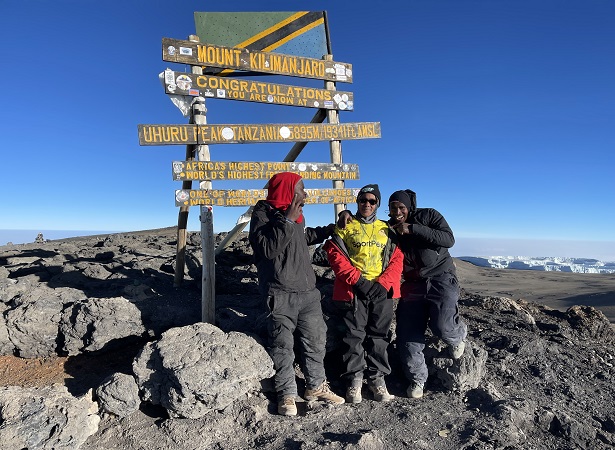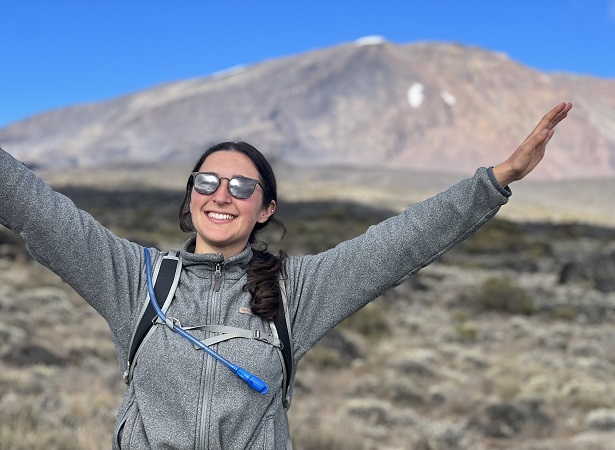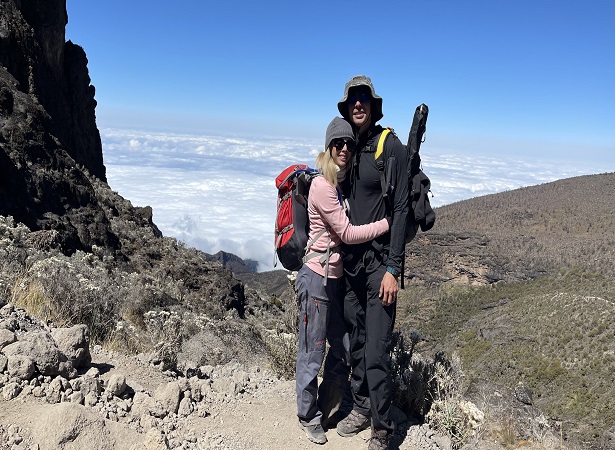6 DAYS KILIMANJARO MACHAME ROUTE
Machame Route, also known as the Whiskey route, has become very popular. This is camping route which offers spectacular views of various landscapes such as Mt Meru, Pare Mountains, Lake Chala and Lake Jipe. While the 6 day itinerary is very possible, it is very beneficial to have the seven days Machame climb because of having one more extra day for acclimatization and resting before the summit day. Doing this will reduce chances of getting altitude sickness and maximize your chance of reaching the summit.
Day 0: Arrival:
Upon your arrival at Kilimanjaro International Airport, you will be met with our ground handling team and after greetings and introduction you will be transferred to your delightful accommodation in Arusha/Moshi for evening rest and overnight.
Day 1: Transfer to Machame gate + Trek from Machame gate to Machame Camp:
Wake up early and after breakfast and briefings board a transfer car to the start point of your hike which will take us around 3hrs. The climb starts from Machame Gate (1,800 m.) and follows a ridge through dense montane forest. This is the richest forested area on the mountain, and also the zone from where 96 % of the water on Kilimanjaro originates. On sunny days, and especially in the dry season, this section is very lush and beautiful; it can also be a very muddy experience, particularly if it has rained recently! We have lunch at ‘Halfway Clearing’, a small opening in the trees, and continue climbing steadily. The gradient becomes gentler as the forest slowly merges into giant heather close to the next camp near the ruins of Machame camp (3,000 m.). We may get our first closer look at the glaciated dome of Kibo if the evening clouds permit. [6-8 hours walking]
Day 2: Machame Camp to Shira Cave camp
A shorter day that begins by climbing up a steep ridge to reach a small semicircular cliff known as Picnic Rock. There are excellent views of Kibo and the jagged rim of Shira Plateau from here,and it is a good rest point too! The trail continues less steeply to reach the Shira Plateau. We camp near Shira camp (3,840m.) which has some of the most stunning views on Kilimanjaro; close to the huge volcanic cone of Kibo, the spectacular rock formations of Shira Plateau, and looking across to Mt. Meru floating on the clouds. [4-6 hours walking]
Day 3: Shira cave camp to Barranco camp
A morning of gentle ascent and panoramic views, leaving the moorland plateau behind to walk on lava ridges beneath the glaciers of the Western Breach. After lunch at the Lava Tower (4,600 m.) we descend to the bottom of the Great Barranco valley (3,900 m.), sheltered by towering cliffs and with extensive views of the plains far below. [5-7 hours walking]
Day 4: Barranco camp to Barafu camp
A steep climb up the Barranco Wall leads us to an undulating trail on the south-eastern flank of Kibo, with superb vis5tas of the Southern Icefields. The terrain changes to scree, with pockets of vegetation in sheltered hollows, and there is only a short distance we will have lunch at Karanga (4,000 m), the last water point on the way to the summit. We follow an easy path on compacted scree with wide views that gains altitude unrelentingly to reach the Barafu campsite (4,600 m) (4 – 5 hours walking)
Day 5: Uhuru peak summit + Descend to Millennium/Mweka camp
We will start our ascent by torchlight at about 1 a.m. so that we can be up on the Crater rim by sunrise. The steep climb over loose volcanic scree has some well-graded zig-zags and a slow but steady pace will take us to Stella Point (5,735 m), in about five or six hours. We will rest there for a short time to enjoy the sunrise over Mawenzi. Those who are still feeling strong can make the two-hour round trip from here along the crater rim to Uhuru Peak (5,896 m), passing close to the spectacular glaciers and ice cliffs that still occupy most of the summit area. The descent to Barafu is surprisingly fast, and after some refreshment, we continue to descend to reach our final campsite (3,800 m) Millennium. [11-15 hours walking]
Day 6: Descend from Millenium Camp to Mweka gate + Transfer back to hotel
A sustained descent on a well-constructed path through lovely tropical forest alive with birdsong and boasting lush undergrowth with considerable botanical interest. Our route winds down to the National Park gate at Mweka (1,650 m). Here we sign out from the national park before walking on for a further 15 minutes through coffee and banana farms to Mweka village where our vehicle awaits ready to transfer you back to your hotel. The shower, the beer, and the swimming pool are tantalisingly close! [4-6 hours walking]
Known as the Whiskey route, the Machame route is now the most popular route on the mountain. Compared with Marangu, the days on Machame are longer and the walks are steeper. The Machame route is considered a difficult route, and is better suited for more adventurous folks and those with some hiking or backpacking experience.
The route begins from the south, then heads east, traversing underneath Kilimanjaro’s southern ice field before summiting. The minimum number of days required for this route is six days, although seven days is recommended.
The Machame route is scenically beautiful and varied. However, due to the heavy crowds, it loses some of its spendor.
For those who only have six days to climb Kilimanjaro, the Machame route is the best choice because of its acclimatization profile. Compared to other six day routes, the Machame route exposes the climber to higher elevations quicker (day three) which kickstarts the body’s adaptation to altitude. However, this route requires that a person be in good shape to be able to tackle the challenging elevation gains and losses.
The six day Machame variation is a difficult route. In particular, day four combined with day five makes for a very hard schedule. Day four is a full day of hiking from Barranco to Barafu. Then after dinner and a partial night’s sleep, the very long and strenuous summit day begins around midnight. The 6 day Machame route requires 19-24 hours of demanding walking, at extremely high elevation, with only 4-6 hours of sleep.
Price Per Person in US Dollars
- $2,200 per person when Solo trekker
- $2,100 per person when 2 people treks together
- $2,000 per person when 3 people treks together
- $1,900 per person when 4 people treks together
- $1,800 per person when 5 people treks together
- $1,700 per person when 6+ people treks together
What’s Includes
- Transport from/to park gate & airport transfer
- Pre and post climb accommodation (B&B) in Moshi
- Park, camping & rescue fees
- Mountain tent & mattress
- Professional English speaking guide(s), porters & chef
- breakfasts, lunches and dinners
- Water; tea and coffee with meals
What’s not included
- Flights
- Lunch & dinner in Moshi
- Travel insurance
- Visa and passport fees
- Increases in park fees where applicable
- Personal equipment
- Sleeping bag
- Tips for guide(s), porters & cook
- Soda and Alcoholic beverage
Book the Tour
Related Kilimanjaro Tours
- From: $.3200
- From: $.2400
- From: $.2,600
- From: $.2800
- From: $.3,200
- From: $.2800
- From: $.2800
- From: $.3,200
- From: $.2000
Mount Kilimanjaro Climbing Routes
When it comes to embarking on a Kilimanjaro climbing expedition, choosing the right route is crucial for a successful and enjoyable experience. With several routes to choose from, each with its own characteristics and challenges, it’s important to consider various factors before making your decision. There are various routes to choose from when climbing Mount Kilimanjaro, each offering different landscapes, challenges, and experiences.
The Marangu Route is one of the most popular routes for those who want to trek to the top of Mount Kilimanjaro. Also known as the “Coca-Cola Route,” it is the only route that offers hut accommodations and is considered the easiest route. However, this also means that it can be crowded during peak season.
The Machame Route is also known as the “Whiskey Route” and is the most popular trekking route in Tanzania. It is a challenging route but also the most scenic due to the panoramic views of the Shira Plateau and the Western Breach. With its rocky terrain, trekking poles are highly recommended.
Rongai route ascends Mount Kilimanjaro from the north-eastern side of the mountain, along the border between Tanzania and Kenya. The rongai route retains a sense of unspoiled wilderness. The Rongai route is the only route that approaches Kilimanjaro from the north.
The Lemosho Route is the best way to climb Kilimanjaro and experience the breathtaking beauty of the mountain. With its numerous advantages, including scenic views, diverse flora and fauna, and a higher success rate, you can be sure of an unforgettable experience.
Kilimanjaro’s Northern Circuit Route is a remote and beautiful trail, but it’s a challenging trek that requires careful planning and preparation. It is the longest route on Kilimanjaro. It offers amazing scenery, excellent acclimatization, and a quiet trek. This is the reasons we love this Kilimanjaro route!
Proper acclimatization and physical preparation are crucial to reach the summit of Mount Kilimanjaro via the challenging Umbwe Route. The route includes several acclimatization days, and proper preparation will enable climbers to tackle the final ascent towards Stella Point.
The route approaches Mount Kilimanjaro from the west, beginning with a long drive from Moshi to Shira Ridge. The vehicle bypasses the rain forest zone and the hiking trail begins on Shira Ridge. The Shira route crosses the entire Shira Plateau from west to east in a pleasant, relatively flat hike.
Kilimanjaro mountain bike trail itinerary is the new service for summiting Mt Kilimanjaro for active and adventure lovers. The Kilema route is the only route that you can reach to the summit by mountain bike. Our experienced guides have done a sufficient number of successful bike trails to the summit.
Mount Meru(4,566 m) is an active stratovolcano and forms the centrepiece of Arusha National Park in Tanzania. Although the mountain is not as high as Kilimanjaro, it is just as challenging. Known for its beautiful green surroundings and abundant wildlife, Mount Meru is the second highest in Tanzania.





















